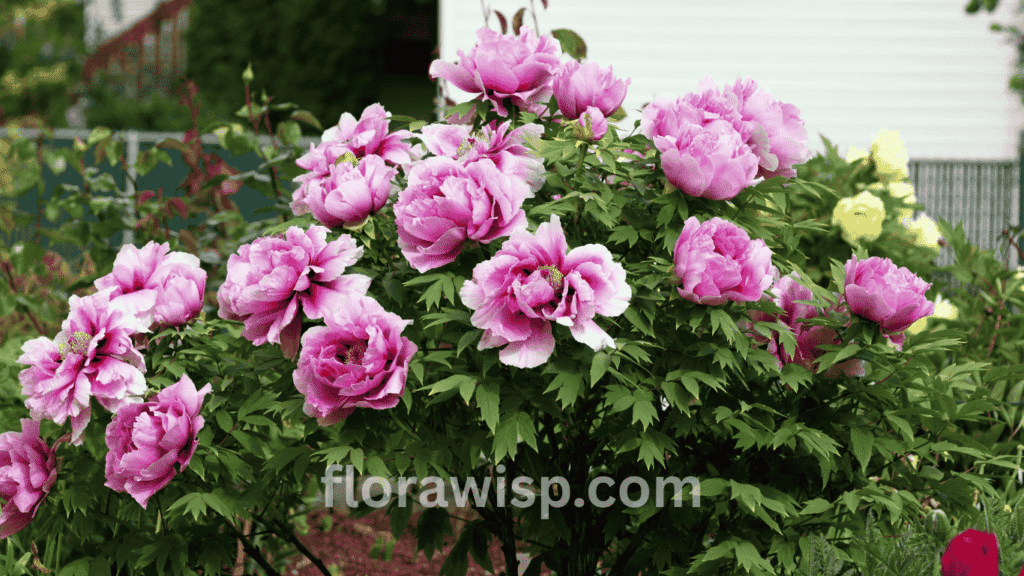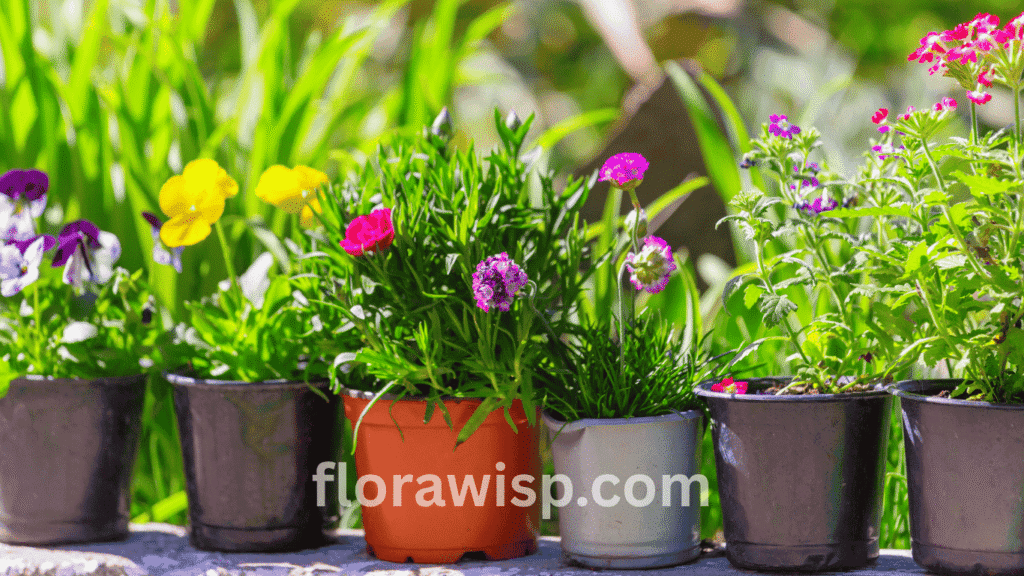Tree peony(Paeonia suffruticosa) is long-lived, woody shrubs celebrated for their large, silk-like blooms, diverse colors, and remarkable ability to thrive for decades, often over a century with proper care. Unlike herbaceous peonies, their woody stems stay above ground year-round, adding structure to the garden even in winter. Peony flower Blooming in mid- to late spring, tree peonies produce flowers that can span up to 10 inches across, releasing a delicate fragrance that enhances any outdoor space.
These shrubs prefer well-drained soil, a sunny to partially shaded spot, and minimal disturbance once established. Their deep roots make them drought-tolerant and low-maintenance after the first few years. Available in single, semi-double, and double blooms, tree peonies come in shades from pure white to deep purple, offering endless design possibilities.
Whether you’re planting your first shrub or curating a collection, tree peonies reward patience with unmatched beauty, resilience, and a living legacy that can be passed down through generations making them a true jewel for gardeners in USDA Zones 4–9.
In This Article
Tree Peony Quick Reference Chart
| Feature | Details |
| Botanical Name | Paeonia suffruticosa |
| Common Names | Tree peony, peony tree, flowering peony tree |
| Plant Type | Deciduous woody perennial shrub |
| Mature Size | 3–5 ft tall, 3–4 ft wide (variety dependent) |
| Bloom Time | Mid- to late spring (varies by variety) |
| Flower Size | 6–10 inches across |
| Flower Colors | White, pink, red, purple, yellow, bi-color |
| Hardiness Zones | USDA Zones 4–9 (variety dependent) |
| Sunlight Needs | Full sun to partial shade (afternoon shade in hot climates) |
| Soil Requirements | Well-draining, fertile, slightly acidic to neutral soil (pH 6.0–7.0) |
| Watering Needs | Moderate; deep watering once a week during dry spells |
| Fertilization | Balanced slow-release fertilizer in early spring after bloom |
| Lifespan | 50–100+ years with proper care |
| Propagation Methods | Seeds, grafting, division |
| Special Care | Minimal pruning, protect from strong winds, mulch in winter |
| Notable Varieties | High Noon, Shima Nishiki, Shimadaijin, Hanakisoi, White tree peony, Renkaku |
| Best Uses | Focal points, mixed borders, cottage gardens, collectors’ displays |
Understanding Tree Peonies: A Gardener’s Overview
What Makes Tree Peonies Unique
In my years of gardening, the tree peony has earned a permanent place in my heart and my yard. Unlike herbaceous types that vanish into the soil each winter, a herbaceous peony vs tree peony comparison reveals a dramatic difference: tree peonies keep their woody framework year-round, giving your garden structure even in the colder months.
When comparing a peony tree vs bush, I always tell fellow gardeners that tree peonies take a little longer to reach their prime, but the wait is well worth it. Once established, they produce massive blooms often 8 to 10 inches wide on sturdy, upright stems that never flop under the flower’s weight. Many fall under the suffruticosa tree peony group, prized for their ability to thrive for decades, sometimes over a century with proper care.
The display they give is more than just a flowering moment; it’s a seasonal performance. It starts with lush green foliage in early spring, peaks with a dramatic explosion of color and fragrance in late spring, and finishes with decorative seed pods that carry the garden’s charm into summer. If you’re ready to experience this kind of beauty in your own yard, explore my complete guide on Growing Peonies to learn everything from planting to long-term care.
Popular Tree Peony Varieties: History & Features
Japanese Tree Peony
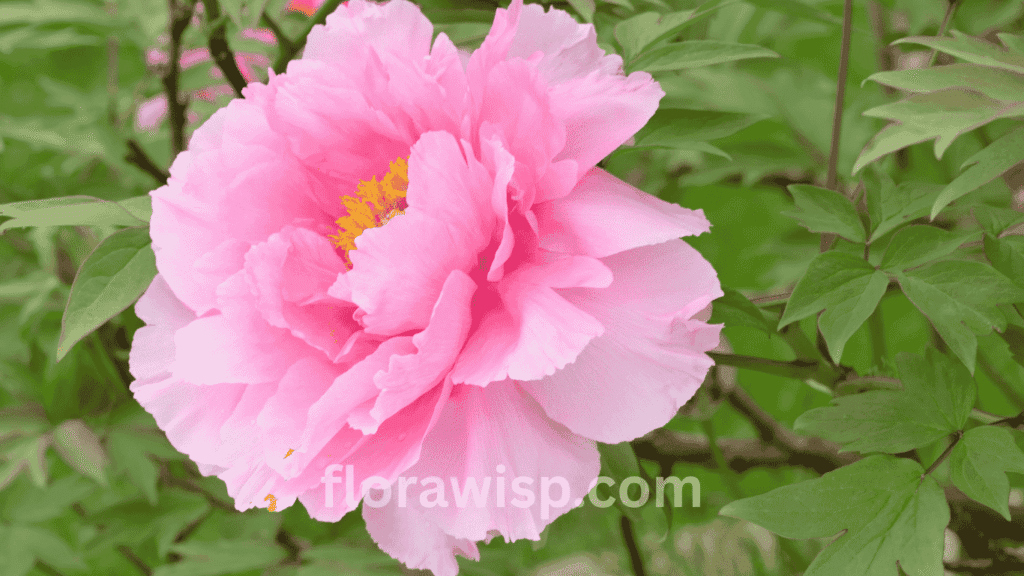
Scientific Name: Paeonia suffruticosa (Japanese cultivar)
USDA Zones: 4–9
Bloom Time: Mid to late spring
Flower Size: 6–8 inches wide
Light: Full sun to partial shade
Notable Trait: Known for upright growth and vibrant jewel-toned blooms
First introduced to Japan from China in the 8th century, Japanese breeders refined these peonies for vibrant colors and large, open blooms. My Shimadaijin bursts with deep royal-purple petals that seem to glow at dusk, making it a showstopper in shaded garden spots.
Chinese Tree Peony
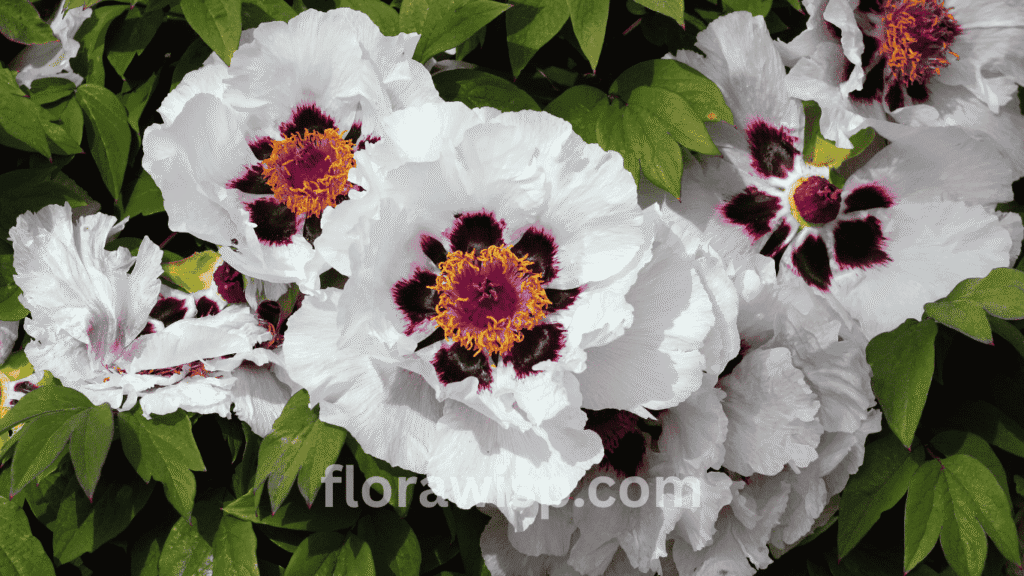
Scientific Name: Paeonia suffruticosa (Chinese cultivar)
USDA Zones: 4–9
Bloom Time: Mid to late spring
Flower Size: 8–10 inches wide
Light: Full sun to partial shade
Notable Trait: Exceptionally fragrant with a long history in Chinese gardens
The tree peony’s ancestral origin, cultivated for over 1,000 years in imperial gardens. My Hanakisoi offers romantic blush-pink petals with a silken texture, while Renkaku opens pure white with a soft blush center, its fragrance lingering even on warm evenings.
Yellow Tree Peony
Scientific Name: Paeonia lutea hybrid
USDA Zones: 4–9
Bloom Time: Late spring
Flower Size: 6–8 inches wide
Light: Full sun to partial shade
Notable Trait: Rare golden blooms and citrusy scent
Yellow tones are rare in peonies, first achieved through hybridization in the mid-20th century. My High Noon blooms with lemon-gold petals and a refreshing citrus scent perfect for brightening the dullest garden corners.
Bi-Color Beauties
Scientific Name: Paeonia suffruticosa ‘Shima Nishiki’
USDA Zones: 4–9
Bloom Time: Mid-spring
Flower Size: 7–9 inches wide
Light: Full sun to partial shade
Notable Trait: Striking hand-painted appearance with red and white petals
Originally bred in Japan for their artistic appeal, these varieties look like living watercolors. My Shima Nishiki feels like it’s been hand-painted, its petals a dramatic mix of creamy white and deep rose-pink peonies.
White Tree Peony
Scientific Name: Paeonia suffruticosa (white cultivar)
USDA Zones: 4–9
Bloom Time: Mid-spring
Flower Size: 8–10 inches wide
Light: Full sun to partial shade
Notable Trait: Large, luminous blooms with a classic, refined look
A timeless favorite in both Chinese symbolism and Western gardens, representing purity and prosperity. My mature white tree peony glows in early morning light, pairing beautifully with lavender’s purple haze for a serene border. For more inspiration and care tips, explore my complete guide on White Peonies to make these elegant blooms a highlight in your own garden.
Choosing & Buying the Perfect Tree Peony
My first tree peony was an impulse buy from a local nursery, and while it was beautiful, I quickly realized that the right selection process makes all the difference in its health, longevity, and bloom quality.
Where to Buy Quality Plants
When shopping for a tree peony, I always check two things first: the age of the plant and the condition of its roots. Mature plants aged 3–5 years tend to establish faster and produce blooms within a year or two, while younger ones may take longer. Healthy roots should be firm, with no signs of rot or mold.
Local nurseries sometimes stock mature specimens, but for rare or heritage varieties such as the Chinese tree peony I’ve had the best success with reputable mail-order nurseries. Ordering in fall for a spring planting gives the plant a head start, as the cooler months help roots settle before the growth surge in spring. I personally prefer bare-root plants because they adapt more easily to my garden soil, though potted plants can be a good choice for beginners.
Picking Varieties for Your Climate
Matching the variety to your growing conditions is the secret to long-term success. Most tree peonies flourish in USDA Zones 4–8, but some cultivars can handle warmer climates with a bit of strategic care. For example, in Zone 9, I recommend choosing heat-tolerant types and planting them where they’ll get morning sun and afternoon shade.
When I helped a friend establish a tree peony garden in Florida, we focused on soil preparation adding grit for drainage and spacing plants widely for better airflow. This helped prevent fungal issues in the humid climate. If you’re unsure, check a tree peony growing area map to guide your choices.
Popular Varieties to Consider
Here are a few varieties I’ve grown or admired over the years, each with its own personality:
- Shimadaijin: Deep magenta petals with a golden center; blooms in mid-season; grows 4–5 ft tall.
- Kamada-nishiki: Soft lavender-pink blooms; late spring; fragrant and sturdy.
- Renkaku: Pure white with ruffled edges; blooms in late spring; reaches 3–4 ft.
- Hana-kisoi: Pink blush petals; early-mid season; ideal for compact gardens.
- High Noon: Yellow blooms; repeat flowers in summer; grows up to 5 ft.
A quick reference for Shimadaijin: Hardy to Zones 4–8, prefers full sun to part shade, average bloom diameter 8–9 inches.
Choosing the right tree peony is an investment that rewards you with decades of breathtaking spring displays if you start with the right plant in the right place.
Planting Tree Peonies Like a Pro
Planting a tree peony is one of the most rewarding tasks in early autumn. These shrubs are more than seasonal beauties; they’re investments that can outlive their planter, often thriving for 50 years or more when given the right start.
Best Time and Location for Planting

I prefer planting in early fall. The soil is still warm enough to encourage root development, and the cool weather reduces transplant stress. A sunny location with a touch of afternoon shade keeps blooms vibrant without scorching the petals.
If space is limited, a tree peony in pots is an excellent choice. I’ve grown them successfully on my patio by using a deep tree peony pot at least 18 inches deep to accommodate their long taproots. Good drainage is essential to prevent rot.
Step-by-Step Planting Guide
Here’s my tried-and-true method for getting a tree peony off to a strong start:
- Dig generously twice as wide as the root ball to allow easy root spread.
- Amend the soil with compost for added nutrients.
- Position the crown about 2 inches below the soil surface (slightly deeper for grafted plants).
- Water deeply to settle the soil around the roots.
- Mulch lightly to retain moisture while avoiding direct contact with the crown.
Remember, a full grown tree peony can spread 4–5 feet wide, so give it space to mature. Varieties like peony tree pink or purple peony tree create breathtaking focal points when planted against dark evergreens.
Growing Tree Peonies from Seeds & Seedlings
Growing a tree peony from seed is a slow but rewarding journey. Fresh tree peony seeds need stratification about three months of cold treatment to trigger germination. Once sprouted, tree peony seedlings require patience, as it may take 5–7 years before the first bloom. The payoff is a plant naturally adapted to your garden’s soil and climate.
Tree Peony Propagation Methods
Beyond seeds, I’ve had great results with peony tree propagation by grafting onto herbaceous rootstock. This method produces faster-blooming plants while maintaining the variety’s traits. Division of mature clumps is possible but rare, as tree peonies prefer to remain undisturbed. The propagation of tree peonies requires precision sharp, sanitized tools, gentle handling, and close monitoring to protect tender new growth from pests.
Plant your tree peony with care, and you’ll be rewarded with a living sculpture that graces your garden for generations.
Tree Peony Care Through the Seasons
Caring for a tree peony isn’t complicated once you understand its rhythm through the year. I’ve learned that this plant rewards consistent, gentle attention rather than aggressive maintenance. Whether in my main garden beds or large pots, I follow a seasonal routine to keep them healthy and blooming.
Spring & Summer Care
Once the breathtaking blooms fade, I always feed my tree peony with a balanced slow-release fertilizer for tree peonies. This post-bloom feeding strengthens the roots and sets the stage for next year’s flowers. Deep watering every 7–10 days during dry spells helps maintain steady moisture without waterlogging the roots. I also remove spent blooms promptly this simple step ensures the plant redirects its energy toward forming strong buds for the following season. Pest issues are rare in my experience, but I keep an eye out for aphids and botrytis. If they appear, a quick spray with a mild horticultural solution early on usually solves the problem.
Autumn Preparation
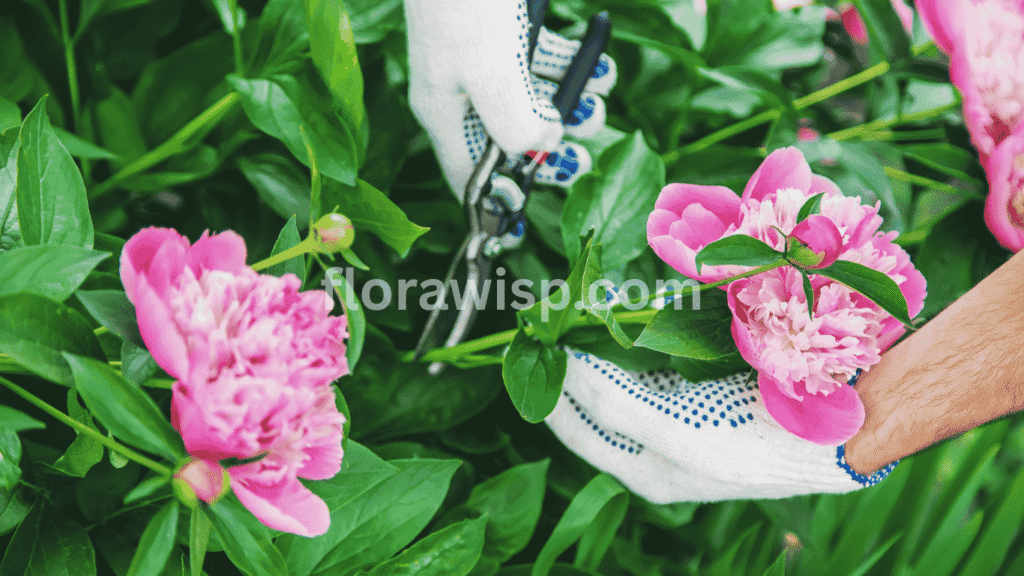
Pruning tree peonies in fall is minimal in my garden, just a light trim to remove dead wood and a little shaping to maintain balance. For tree peony fall care, I also apply a 2–3 inch mulch layer around the base. This keeps roots insulated and helps prevent weed competition through winter.
Winter Protection & Dormancy
In colder USDA Zones, winter can be harsh on roots. I pile mulch generously around the base for in-ground plants, while my potted tree peonies spend winter in a sheltered, frost-free corner of the patio. During these months, the tree peony in winter stands bare and graceful, conserving energy until spring.
From my experience, following this seasonal routine results in healthier plants, bigger blooms, and far fewer pest or disease problems year after year.
Managing Tree Peony Foliage and Leaves
Identifying Healthy Tree Peony Leaves
A thriving tree peony will display broad, deeply lobed leaves in a vibrant, deep green shade. In my own garden, these healthy leaves not only signal good plant health but also enhance the overall beauty of the shrub from spring through late summer. A healthy tree peony leaf should feel firm, without curling, and show no signs of mottling or spotting.
Spotting Early Signs of Trouble
Yellowing leaves on a tree peony often point to nutrient deficiencies most commonly nitrogen or magnesium. If only the lower leaves are yellowing while the upper ones remain green, the plant may simply be reallocating resources toward bloom production. However, if yellowing spreads quickly, it’s time to test the soil and adjust fertilization.
Brown or black spots, especially during humid spells, can indicate fungal infections such as botrytis blight. In my experience, promptly removing and discarding affected leaves and not composting them can prevent the spread. Good airflow around the plant and avoiding overhead watering have been key in keeping my tree peonies healthy year after year.
Troubleshooting Common Tree Peony Problems
Poor Blooming
If your tree peony produces few or no blooms, planting depth is often the culprit. The graft union should be buried about 4–6 inches below the soil surface. I’ve found that planting too shallowly can delay flowering for years. Over-fertilization, particularly with high-nitrogen formulas, can also cause lush foliage growth at the expense of blooms. A balanced, slow-release fertilizer applied in early spring works best.
Leaf Spots and Fungal Issues
Botrytis and other fungal leaf spots can develop in wet, humid conditions. In my garden, I manage this by removing debris around the plant in fall, applying a mulch layer to reduce soil splash, and ensuring proper spacing between shrubs for airflow. A copper-based fungicide, applied as a preventive during wet spells, has also helped keep my tree peony foliage disease-free.
Transplant Shock and Recovery
When relocating a mature tree peony, patience is essential. These shrubs can take a full season or even two to fully recover and resume normal blooming. During recovery, I keep watering consistent, mulch generously to regulate soil temperature, and resist the urge to over-fertilize.
Adapting to Climate Changes
Unexpected heatwaves or late frosts can stress tree peonies. I’ve used temporary shade cloth during extreme heat and extra mulch to protect roots in colder snaps. Observing how your plant responds and making small adjustments has helped me keep my tree peonies thriving through unpredictable seasons.
Incorporating Tree Peonies into Your Garden Design
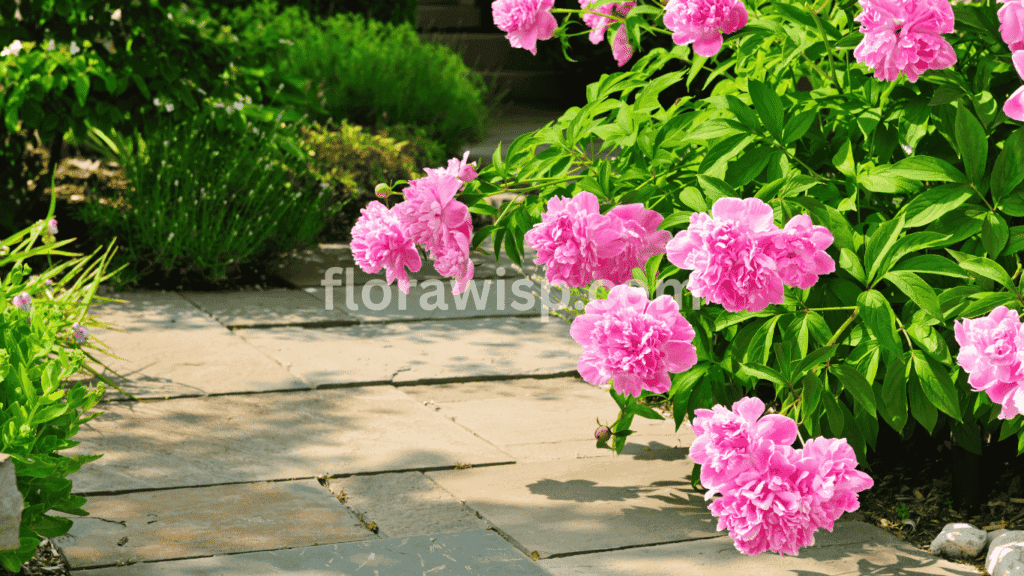
Tree peonies are one of my favorite ways to add a timeless focal point to a garden path. Their woody stems, large blooms, and ability to live for decades make them more than just plants; they become garden landmarks, especially when planted alongside a path with the garden aisle at the center.
Layering for Seasonal Color
I’ve found that planting tree peonies alongside early-blooming spring bulbs like tulips and daffodils creates a breathtaking sequence of color. As the bulbs fade, the tree peony takes center stage with its large, show-stopping blooms. For a seamless transition into summer, I like to pair them with perennials such as daylilies or salvia, which keep the garden vibrant long after the peony flowers fade.
Creating a Color Gallery
Tree peonies offer an impressive color palette, from pure white and blush pink to deep crimson and golden yellow. Grouping contrasting shades together creates what I call a “living gallery” a natural display that changes subtly each season. One corner of my garden has a white ‘Shimadaijin’ tree peony next to a vivid red variety, and each spring they draw the most compliments from visitors.
Rare & Collectible Tree Peonies
For gardeners who like to grow something truly special, rare and collectible tree peonies can be a rewarding addition. Their history, unique bloom forms, and limited availability make them standouts in any landscape.
The Beauty of Itoh Tree Peonies
One hybrid I particularly admire is the Itoh tree peony, a cross between herbaceous and woody peonies. These plants combine the strong stems and extended bloom period of herbaceous peonies with the exquisite flower forms of tree peonies. In my experience, they’re remarkably hardy and often produce blooms in unusual shades like apricot, coral, and even lavender. If you’re drawn to vibrant garden colors, pairing them with a classic Red Peony can create a breathtaking seasonal display.
FAQs
Q. What is a peony tree?
A peony tree is a woody perennial shrub that keeps its stems year-round, unlike herbaceous peonies that die back in winter. In my garden, these shrubs grow slowly but are rewarded with decades of enormous blooms, often reaching 4–5 feet tall. Their lifespan and bloom size make them a gardener’s gem.
Q. Where to buy tree peonies?
You can buy tree peonies from local nurseries or specialty online retailers. I’ve found that mail-order sources often offer rare varieties like Chinese tree peony and Japanese tree peony. Always choose healthy plants from reputable sellers to ensure strong growth.
Q. How to trim a peony tree?
Trim a peony tree in late fall or early spring by removing dead or weak wood. I shape mine lightly to maintain airflow and encourage new growth. Avoid heavy pruning, as buds form on old wood.
Q. How to grow a tree peony?
To grow a tree peony, plant it in well-drained soil with morning sun and afternoon shade. I water deeply once a week and mulch lightly. Patience is key, full blooms often appear after 3–4 years.
Q. How to plant a tree peony?
Plant a tree peony with its crown 2 inches below soil level in a wide hole enriched with compost. I prefer early fall planting so roots establish before winter. Space plants are mature , spread and water deeply.
Conclusion
Growing a tree peony is like nurturing a lifelong friend; it rewards patience with unmatched beauty. From selecting the right variety to mastering seasonal care, these plants offer decades of joy. As I walk past my oldest tree peonies, now towering and covered in blooms, I’m reminded that gardening is as much about time and care as it is about flowers. Their blossoms, often gathered into a Peony Bouquet, capture not only the charm of the garden but also the elegance of tradition.
References
American Peony Society – Tree Peony Overview
Missouri Botanical Garden – Paeonia suffruticosa Profile
Chicago Botanic Garden – Tree Peony Collections
Gardener, M.Sc. Horticulture
Elara Bennet is a gardening writer from Austin, TX, passionate about sustainable lawns and blooms. Read full bio →

